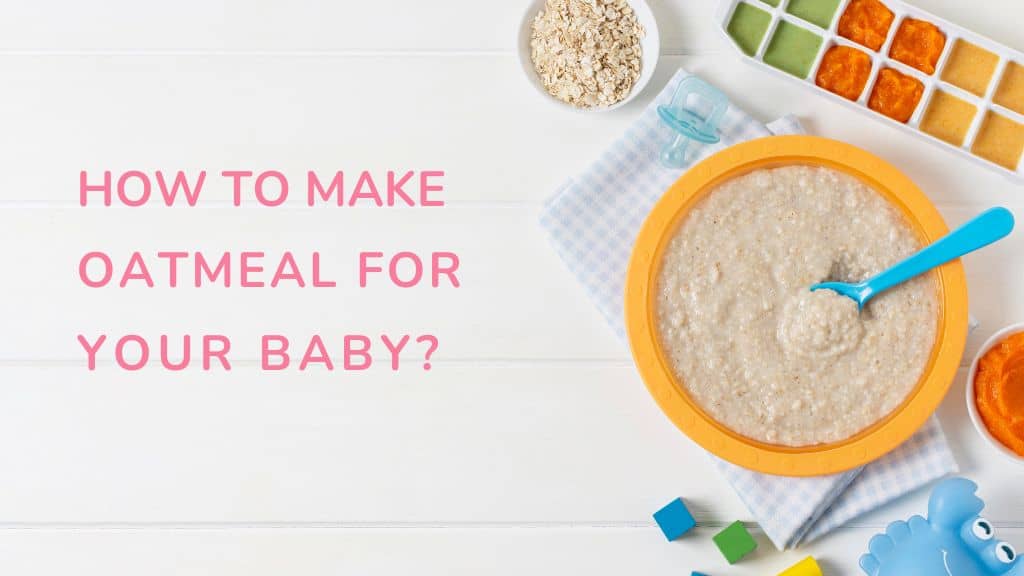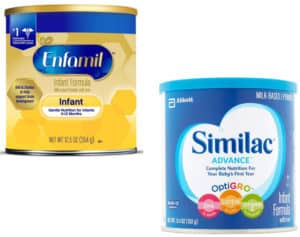
Table of Contents
Oatmeal lovers alert! Are you an oatmeal-loving parent wondering if you could feed your baby oats? What types of oats are best for babies? Are rolled oats too tough to chew for babies? We are here to solve all your queries about oatmeal for babies.
For starters, oatmeal is a great diet plan for babies. They have a low risk of causing an allergic reaction, are easy to digest, and are mild. Store-bought oatmeal for babies is just ground-up rolled oats or oat flour. They are super easy to make and are fortified with iron. The ones you make at home may not have that much iron content.
Oats also contain micronutrients like choline, betaine, manganese, copper, vitamin E, etc. apart from high iron content. There is about 1.2 mg of iron in 234 grams of oats along with plant proteins like folate, zinc, magnesium, and fiber. The soluble fiber beta-glucan present in oats is great for a healthy gut and reducing blood sugar and cholesterol levels.
So, How to Make Baby Oatmeal?
Making oatmeal for babies is as easy as making pureed food. Feel free to add toppings and mix-ins to give the oatmeal a bit more variety and flavor. Keep reading to find out the recipe for how to make oatmeal for a baby for 5 and 6 months old babies.
How to Make Baby Oatmeal With Cereal For 5 Months Old Babies
Here’s how to make baby oatmeal with cereal:
- Grind some old-fashioned oats in a high-powered blender or food processor until they are finely ground like flour.
- Boil half a cup of water and sprinkle 2 tablespoons of ground fine oats.
- Whisk for 30 seconds and then occasionally stir for 3 to 5 minutes as it cooks.
- Remove the oats when they are creamy and thick.
- Let it cool.
- Add baby formula or breastmilk to get your baby’s desired consistency. Make it super thin if your baby is a new eater.
You may store the ground oars in an airtight container in your refrigerator or a cool and dark place.
How to Make Baby Oatmeal for 6 Months Olds
These 6-month-old baby oatmeal recipes have been curated with 3 different types of oats. Let’s check them out!
Quick Oats
Instant oats or quick oats are the most processed of all types of oatmeals. They are pre-cooked, dried, rolled, and pressed before coming to the supermarket aisle. They cook faster than steel-cut oats and are thinner than rolled oats. However, they lose their texture as it cooks, turning mushy by the time you feed them to your child. Here’s a sample recipe:
- Add ¼ cup of instant oats to ½ cup of boiling water.
- Stir it to combine in medium heat for 1 minute.
- Let it cool after 1 minute of heating.
- Add water, baby formula, or breast milk as needed.
- Add toppings or mix in to increase the flavor.
Old Fashioned Rolled Oats
These are old groats that have been steamed and rolled. Old-fashioned oats are super quick to cook making them a great time-saver during your morning rush. Here’s how to cook it:
- Add ¼ cup of old-fashioned rolled oats to ¾ cup of boiling water.
- Stir the mixture in medium heat for 5 to 7 minutes (you’ll know it’s done when all the liquid has been absorbed).
- Remove the oats from the heat and set them to cool.
- Add water, baby formula, or breastmilk to thin its consistency.
- You may also top it with cut fruits or other mix-ins.
Steel Cut Oats
Steel-cut oats are the least processed of all types of oats. The full oat grain is cut into 2 or 3 parts to make steel-cut oats. They are the chewiest and most dense oatmeal option which means they are perfect for teething babies. Here’s how to make steel-cut oatmeal for babies:
- Add ¼ cup of oats to ¾ cup of boiling water.
- Stir the mixture to combine and then reduce to a simmer for half an hour or 20 minutes. You will know it’s done when all the liquid has been absorbed. Remember to stir occasionally while it cooks.
- After removing it from the heat, set it to cool.
- Add water, formula, or breastmilk if the consistency is too thick for your baby.
- Add toppings or mix-ins to increase the flavor.
How to Flavor Oatmeal for Babies
Oats can taste bland (even for adults) and you must add some fun to their flavor. For younger babies, you could add pureed food with nutmeg and cinnamon sprinklings. Check out some pureed baby food r recipes! Whichever toppings you are adding make sure they are not huge chunks to avoid choking hazards.
You can also try these foods as flavor enhancers in the oatmeal for your babies:
- Tofu pumpkin curry
- Mashed banana slices
- Pinches of cinnamon or nutmeg
- Peanut (after ruling out any allergies), sunflower seeds, cashew, or almond butter
- Ground chia seeds or flaxseed
How to Serve Oatmeal as Finger Food
Oatmeal congeals when you store them in the refrigerator. You can cut them up and serve them as finger foods for your older babies. No more leftover oats! Here are some additional methods to prepare oatmeal as finger food. You could include
- Baked oatmeal cups
- Porridge fingers
- Oatmeal baby pancakes
- Blueberry baked oatmeal
- Regular baked oatmeal
How to Store Oatmeal Leftovers
Take an airtight container and fill it with any leftover oatmeal. You can store them for up to 4 days after that it’s not safe to eat. If you added baby formula or breastmilk into the oatmeal, then follow the instructions for storing milk. For added toppings or mix-in, you need to check how to store each ingredient. Similar to stews and soups, cooked oatmeals should not be kept any longer than 4 days. However if you are freezing it, it can last you for 3 months.
The Bottom Line: Oatmeal for Babies
Oatmeal is a nutritious staple in almost every household. Processed and uncooked oatmeals can last up to 2 years. The exact shelf life depends on any perishable item in it and add-ons, whether it has been cooked, how you store it, and how it was processed. Once you have stored them (whether it was cooked or uncooked). If you notice any mold, color, or scent changes in it, it’s time to throw them out. How to maximize its shelf life? Keep them away from oxygen and moisture exposure.
Oats have several health benefits such as reducing risks of heart disease, and blood sugar levels and promoting weight loss. Here’s a list of each nutrient as per DV in 78 grams, i.e., half a cup of oats contains:
- Vitamin B5 (pantothenic acid): 9.07%
- Vitamin B1 (thiamin): 15.5%
- Folate: 3.24%
- Zinc: 13.4%
- Iron: 9.4%
- Copper: 17.6%
- Magnesium: 13.3%
- Phosphorus: 13.3%
- Manganese: 63.91
Note: DV stands for daily value (reference amounts of nutrients expressed in micrograms, milligrams, or grams) that should not exceed each day).
Oatmeal For Babies FAQs:
1) How to make baby oatmeal with formula?
2) How to make baby oatmeal with breastmilk?
3) What is the best oatmeal for babies?
4) When can I start my baby on oatmeal?
5) How do I introduce oatmeal to my baby?
Sources:
- https://www.cdc.gov/nutrition/InfantandToddlerNutrition/foods-and-drinks/when-to-introduce-solid-foods.html
- https://www.ncbi.nlm.nih.gov/pmc/articles/PMC4325078/
- https://fdc.nal.usda.gov/fdc-app.html#/food-details/173905/nutrients
- https://www.ncbi.nlm.nih.gov/pubmed/26511097
- https://www.cdc.gov/nutrition/infantandtoddlernutrition/formula-feeding/infant-formula-preparation-and-storage.html
- https://www.foodsafety.gov/food-safety-charts/cold-food-storage-charts
- https://www.fda.gov/food/new-nutrition-facts-label/how-understand-and-use-nutrition-facts-label#:~:text=4.,Percent%20Daily%20Value%20(%25DV)&text=The%20%25%20Daily%20Value%20(%25DV,not%20to%20exceed%20each%20day
- https://fdc.nal.usda.gov/fdc-app.html#/food-details/173904/nutrients
- https://scholarsarchive.byu.edu/cgi/viewcontent.cgi?article=1038&context=facpub#:~:text=Traditionally%2C%20shelf%20life%20studies%20of,still%20had%20acceptable%20sensory%20properties.










